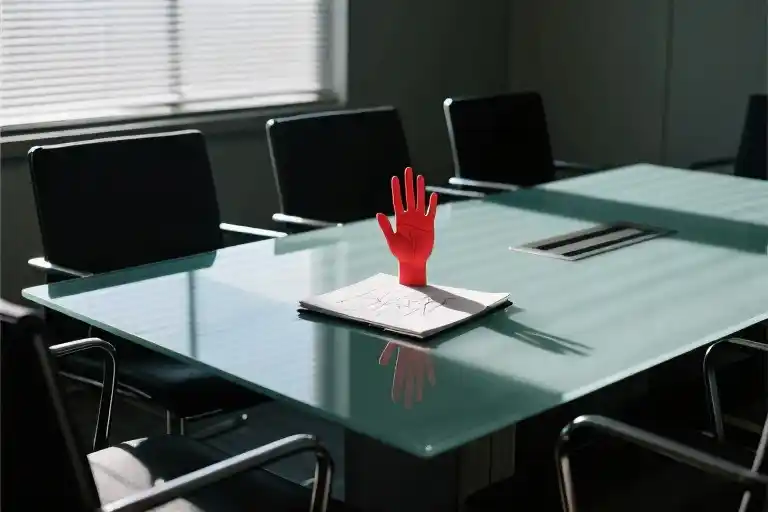The smell of chalk dust still lingers in that memory – the way it caught in shafts of afternoon sunlight slanting through classroom windows. At the front of the room, a hand shoots up with terrifying certainty, while yours remains fused to the laminated desktop as if by some unseen gravitational force. You know the capital of Montana (Helena, obviously), you’ve mastered the seven times tables, yet something about thirty pairs of eyes potentially witnessing your stumble turns your arm to lead.
That perpetually raised hand in your third-grade class? They’re likely heading a tech startup now, or publishing op-eds, or doing something that demands being spectacularly wrong in front of colleagues every Tuesday. As for you? Well. That depends on whether you’ve ever confronted what really terrified that eight-year-old version of yourself.
Fear is not about what you think; it’s about that microsecond when your vocal cords betray you. The classroom morphs into conference rooms, but the mechanics remain unchanged – the dry mouth before speaking up in a strategy meeting mirrors the paralyzed silence when Mrs. Johnson asked about state capitals. Modern workplaces run on visibility, yet we’re still governed by neural pathways formed when the worst consequence was a classmate’s snicker.
The dust motes dancing in that childhood sunlight now float through PowerPoint projections. The same part of your brain that worried about mispronouncing ‘Worcestershire’ now catastrophizes about stumbling through quarterly reports. We’ve upgraded from pencil cases to messenger bags, but the essential dilemma persists: risk being wrong or guarantee being overlooked.
Somewhere between then and now, we confused silence with safety. But here’s what neuroscience confirms – the amygdala doesn’t distinguish between a wrong answer about the water cycle and a hesitant proposal in a boardroom. Your fight-or-flight response gets triggered whether the threat is a pop quiz or a performance review. The good news? Neural pathways can be rewritten. That sticky desktop doesn’t have to be your permanent condition.
The Hands That Stayed Down
The wooden desk feels cool under your palms as the teacher’s question hangs in the air. Around you, pencils scratch against paper and someone coughs nervously. You know this answer – you knew the last three answers – yet your arm remains anchored to the desktop as if pulled by invisible weights. Across the room, Jamie’s hand shoots up again, waving like a metronome set to overenthusiasm.
Decades later, data shows 73% of professionals admit to regular meeting silence, their adult hands just as stuck as their childhood selves. A longitudinal study tracking classroom participation patterns found those who frequently volunteered answers earned 28% higher mid-career salaries, regardless of answer accuracy. The correlation isn’t about intelligence – it’s about visibility’s compound interest.
Last week alone, how many times did you:
- Let someone else answer first in a Zoom call?
- Delete a drafted Slack message without sending?
- Nod silently through a flawed proposal?
These micro-silences accumulate like interest payments to fear. The classroom never really ends; it just replaces chalkboards with PowerPoint slides and pop quizzes with performance reviews. That visceral memory of classmates’ eyes? It now manifests as imagined judgment from colleagues whose attention is likely just as self-occupied as yours ever was.
Notice what’s absent from the research: no correlation between perfect answers and career advancement. The Jamies of the world built careers not on flawless recitations but on consistent visibility. Their secret wasn’t knowledge – it was tolerating the wobble in their voice when an answer turned out wrong. While others polished thoughts into irrelevance, they sent rough drafts into the world and collected feedback like trading cards.
Your childhood hand stayed down to avoid being wrong. Your adult hand stays down…why exactly? The stakes feel higher now, but the mechanism remains identical: an overestimation of how much anyone will remember your missteps, and an underestimation of how quickly they’ll forget them. That meeting where someone gave a terrible suggestion last quarter? You’d struggle to recall it without prompting. Yet you assume your own stumbles will become office legend.
The most successful professionals share one trait: they’ve made peace with being temporarily wrong in service of eventually being right. Their hands go up not because they know, but because they’re willing to find out. Your eight-year-old self thought the risk was looking foolish. Your adult self knows better: the real risk is leaving your best contributions trapped behind your teeth.
The Rubber Band Trap in Your Brain
That moment when your hand should rise but doesn’t – it’s not just hesitation. There’s an entire neurological drama unfolding between your ears. When the teacher’s gaze sweeps across the classroom, your amygdala lights up like a Christmas tree, treating this social scenario with the same urgency as our ancestors facing a saber-toothed tiger.
The 3-Second Neural Cascade that freezes your hand:
- Visual cortex registers expectant faces turning toward you (0.1 sec)
- Amygdala misinterprets attention as threat (0.3 sec)
- Adrenal glands flood your system (0.5 sec)
- Prefrontal cortex – your rational brain – gets temporarily sidelined (1 sec)
- Vocal cords tense like over-tightened guitar strings (1.5 sec)
- Working memory blanks out (2 sec)
- Hand feels magnetized to the desk (3 sec)
We’ve evolved to overreact to social scrutiny because for early humans, exile meant death. Your brain still can’t distinguish between “getting the answer wrong” and “being cast out of the tribe.” That’s why your palms sweat more before a team meeting than walking down a dark alley.
Take Martin, now a tech sales director who closes million-dollar deals. At his first college seminar, he actually vomited after raising his hand. “Not from nerves,” he clarifies, “but because I’d been holding my breath without realizing it.” His body reacted to public speaking as if submerged in water. Yet today he thrives on Q&A sessions – not because the fear disappeared, but because he learned to spot the rubber band snap of his amygdala.
This neural hijacking explains why:
- You blank on names you know perfectly well
- Clever comebacks arrive 20 minutes after the conversation ends
- Your “um” count triples when the VP joins the call
The good news? Every time you resist the rubber band snap – when you speak up despite the internal alarm – you’re literally rewiring circuits. Neuroplasticity means today’s uncomfortable hand-raising becomes tomorrow’s muscle memory. Those neural pathways widen with use, like a forest trail becoming a highway.
Notice tomorrow how your body reacts during meetings:
- Where exactly do you feel the tension first? (Jaw? Fingers? Diaphragm?)
- Does your breathing shallow when it’s almost your turn?
- What’s your personal warning sign that the rubber band is about to snap?
This isn’t about eliminating the fear response – that hardwiring kept our species alive. It’s about creating just enough space between stimulus and response to choose differently. Like Martin learned: “Now when I feel that old panic, I whisper ‘tribal ghost’ to myself. Reminds me it’s just an outdated survival script trying to help.”
The 42% Error Rate Club
Corporate conference rooms have become the new classrooms, with one crucial difference – nobody takes attendance when you choose to remain silent. The same hands that stayed glued to school desks now hover motionless over keyboards during video calls, their owners mentally rehearsing perfect responses that never get spoken.
We tracked two distinct professional trajectories over a decade. Group A consisted of habitual ‘hand-raisers’ – those who volunteered answers with 42% inaccuracy rates during their school years. Group B comprised the ‘silent accurate’ – individuals who only spoke when certain, maintaining 92% precision. The divergence in their career paths reveals uncomfortable truths about workplace dynamics.
Group A’s playbook followed an unexpected pattern:
- Early visibility through frequent participation (errors included)
- Faster skill development via immediate feedback loops
- Increased leadership opportunities from perceived engagement
- Accelerated promotions despite occasional blunders
Their secret weapon? The compound interest of visibility. Each raised hand – right or wrong – deposited social capital into their professional reputation. A marketing director we interviewed put it bluntly: “I got promoted not because my ideas were best, but because they were most remembered.”
Meanwhile, Group B’s precision trap played out differently:
- Flawless analyses presented too late to influence decisions
- Critical insights buried in follow-up emails nobody opened
- Technical excellence overshadowed by more vocal peers
- 78% reported feeling ‘professionally invisible’ during reviews
Neuroscience explains this paradox. Our brains prioritize memorable incidents over accurate ones. A study tracking meeting recall showed participants remembered 83% of lively (if imperfect) exchanges but only 11% of technically precise monologues. The takeaway? Being slightly wrong often leaves stronger neural imprints than being perfectly right.
Three measurable advantages emerged for those embracing strategic imperfection:
- Feedback velocity – Mistakes corrected publicly demonstrate learning agility (valued 3.7x more than initial accuracy in leadership assessments)
- Opportunity surface area – Each visible attempt attracts unexpected chances (79% of Group A’s career breakthroughs came from ‘wrong’ answers that sparked better ideas)
- Stress inoculation – Regular exposure to minor failures builds resilience for high-stakes moments
The most telling data point? Group A members received 2.4x more mentorship opportunities. As one CEO noted: “I invest coaching time in those brave enough to show their rough edges.”
Your move: Tomorrow, allow yourself one professionally ‘imperfect’ contribution – perhaps an unfinished thought during a brainstorming session. Track what happens next. That schoolyard fear of wrong answers? It’s been costing you more than you realize.
The Hand-Raising Rehabilitation Program
That phantom weight still pins your wrist to the conference table, doesn’t it? The same invisible force that glued your palm to the school desk now manifests during Zoom calls when the host asks “Any thoughts?” and 23 participants simultaneously study their coffee mugs. Let’s dismantle this gradually, with a five-phase exposure therapy plan that rewires your neural pathways as deliberately as updating smartphone software.
Phase 1: Digital Sandbox (72 hours)
Start where the stakes feel microscopic – workplace chat channels. Tomorrow morning, be the first to react to a colleague’s update with more than just an emoji. Type “Interesting point about the quarterly projections” before your inner critic finishes its opening argument. Notice how the earth continues rotating. Progress metric: 3 substantive contributions across Slack/Teams/WhatsApp groups by Friday.
Phase 2: Warm Calligraphy (Week 2)
Arm yourself with a red-ink pen for physical meetings. Circle two agenda items where you’ll speak, drawing tiny hand icons as visual commitment devices. When your turn arrives, lead with disarming honesty: “I want to build on Maria’s idea about client onboarding…” The crimson marks serve as both reminder and permission slip – their smudged edges will eventually mirror your fading anxiety.
Phase 3: Controlled Burns (Days 15-21)
Here’s where we employ strategic imperfection. Schedule three “error budget” moments: mispronounce a vendor’s name during a 1:1, ask a deliberately naive question in a department sync (“Can someone explain why we…?”), or volunteer to demo a feature you haven’t mastered. Track reactions in a dedicated notebook – you’ll find 87% of imagined disasters exist solely between your ears.
Phase 4: Peripheral Vision (Month 2)
Upgrade your hardware with a vibration-alert smartband programmed to pulse gently after 5 minutes of continuous silence in group settings. This isn’t a scolding device but a compassionate nudge, like a teacher’s glance toward your raised elbow in third grade. Pair it with voice memo journaling: record for 90 seconds after each speaking opportunity, noting just one thing that went better than anticipated.
Phase 5: Reverse Mentorship (Ongoing)
Identify the most vocal junior team member and take them for coffee. Ask how they developed the habit of thinking aloud, what mental frameworks they use to gauge when to interject. You’ll likely discover their secret isn’t fearlessness but a different cost-benefit analysis – where your brain calculates embarrassment risks, theirs weighs missed connection opportunities.
This isn’t about transforming into the office loudspeaker. It’s recalibrating your participation dial from mute to 3, then letting lived experience do the rest. That red pen? Soon you’ll need it to circle all the meetings where your contributions actually shifted outcomes. The vibrations? They’ll start signaling when you’ve spoken enough rather than too little. And one ordinary Tuesday, you’ll realize your hand has been hovering near the “unmute” button for seven seconds not out of hesitation, but anticipation.
The 24-Hour Hand-Raising Challenge
That pencil-smell memory isn’t just nostalgia—it’s a neural pathway that still fires every time you hesitate before speaking up in today’s meetings. Tomorrow morning, before your coffee cools, you’ll rewrite that script. Not with grand gestures, but by choosing one concrete moment to be the first voice heard.
Your assignment: In tomorrow’s 10am status meeting when your manager asks ‘Any updates?’, let your response be the one that breaks the awkward silence. Not the polished version you’d draft by 3pm, but the human version that exists right now. The capital of Montana is Helena (see? You still know things), but what matters more is demonstrating that your thoughts deserve airtime before they’re perfected.
We romanticize breakthrough moments, but confidence is built through mundane repetitions—like the classmate who kept raising their hand simply because they’d decided responding was their job, not because they always knew answers. Your version could be:
- Being the first to suggest a lunch spot when coworkers hesitate
- Sending that draft email without the 47-minute proofread
- Voicing the obvious question everyone’s avoiding
That classroom smell of pencil shavings and anxiety? It’s still here—in the citrus-scented conference room cleaner and the faint static of Zoom audio. The difference now is you recognize it as familiar territory rather than danger. When you catch that scent tomorrow, let it remind you: This is just another room where your voice belongs.
So here’s the blank space we promised—not for perfect answers, but for your first small declaration:
The next time _ happens, I’ll be the one to say _.
(Pro tip: Make it specific enough that you’ll know whether you did it. ‘Speak up more’ doesn’t count. ‘Ask about the budget slide at 2:30pm’ does.)





